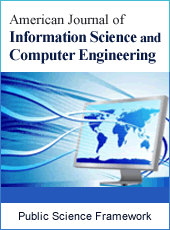American Journal of Information Science and Computer Engineering
Articles Information
American Journal of Information Science and Computer Engineering, Vol.5, No.2, Jun. 2019, Pub. Date: Jun. 24, 2019
An Overview of Big Data and Machine Learning for Energy Forecasting
Pages: 77-81 Views: 1932 Downloads: 305
[01]
Farook Sattar, Department of Electrical & Computer, Engineering, University of Victoria, Victoria, Canada.
Energy forecasting is a technique to predict future energy needs to achieve demand and supply equilibrium. This paper presents an overview on Big Data and machine learning technology in the context of energy forecasting. The overall objective of Big Data is to discover useful information and knowledge that might otherwise be overlooked or discounted. On the other hand, machine learning helps make complex energy systems more efficient as the systems can learn from a large volume of collected data, detect regular patterns, and optimize its own operations. The energy forecasting plays a vital role to predict energy consumption for large commercial customers. The electrical energy sector is now looking for ways to put a higher level of accuracy and reliability into forecasting electrical loads for the next day and for the next week. It is further complicated by the fact that this sector is dependent on other energy sectors including wind, solar, gas, and hydro, all of which are directly affected by weather events. Therefore, development of intelligent prediction systems based on Big Data as well as machine learning techniques is an emerging issue to pursue a sophisticated and highly tuned decision support system for energy forecasting and it involves integration of various large volume of data from numerical energy prediction models, statistical datasets, real time observations, and human intelligence to optimize forecasts for low-cost energy generation.
Big Data, Energy Forecasting, Machine Learning
[01]
B.-A. S.-Leech, B. Barry, M. Muratori, and B. J. Yurkovich, “Big Data issues and opportunities for electric utilities’’, Renewable and Sustainable Energy Reviews, 52, 937-947, 2015.
[02]
K. Grolinger, A. L’Heureux, M. A. M. Capretz, and L. Seewald, “Energy forecasting for event venues: Big data and prediction accuracy’, Energy and Buildings, 112, 222-233, 2016.
[03]
K. Parks, Y.-H. Wan, G. Wiener, and Y. Liu, “Wind energy forecasting: A collaboration of the National Center for Atmospheric Research (NCAR) and Xcel Energy’’, National Renewable Energy Laboratory (NREL). Colorado, USA, 2011.
[04]
C.-D. Yue, C.-C. Liu, C.-C. Tu, and T.-H. Lin, “Prediction of power generation by offshore wind farms using multiple data sources’’, Energies, 12 (4), 2019.
[05]
F. Ardakani and M. Ardehali, “Long-term electrical energy consumption forecasting for developing and developed economics based on different optimized models and historical data types’’, Energy, 65, 452-461, 2014.
[06]
R. K. Jain, K. M. Smith, P. J. Culligan, and J. E. Yaylor, “Forecasting energy consumption of multi-family residential buildings using support vector regression: Investigating the impact of temporal and spatial monitoring granularity on performance accuracy’’, Applied Energy, 123, 168-178, 2014.
[07]
L. Suganthi and A. Samuel, “Energy models for demand forecasting – A review’’, Renewable and Sustainable Energy Reviews, 16 (2), 1223-1240, 2012.
[08]
R. Z. Jovanovic, A. A. Sretenovic, and B. D. Zivkovic, “Ensemble of various neural networks for prediction of heating energy consumption’’, Energy and Buildings, 94, 189-199, 2015.
[09]
R. K. Jain, K. M. Smith, P. J. Culligan, and J. E. Taylor, “Forecasting energy consumption of multi-family residential buildings using Support Vector Regression: Investigating the temporal and spatial monitoring granularity on performance accuracy’’, Applied Energy, 123, 168-178, 2014.
[10]
Z. H. Kilimci, A. O. Akyuz, M. Uysal, S. Akyokus, M. O. Uysal, B. A. Bulbul, and M. A. Ekmis, “An improved demand forecasting model using deep learning approach and proposed decision integration strategy for supply chain’’, Complexity (Hindawi Pub.), Volume 2019, 1-15, 2019.
[11]
M. M. Najafabadi, F. Villanustre, T. M. Khoshgoftaar, N. Seliya, R. Wald, and E. Muharemagic, ``Deep learning applications and challenges in big data analytics’’, Journal of Big Data (Springer), 2 (1), 1-21, 2015.
[12]
X.-W. Chen and X. Lin, “Big data deep learning: challenges and perspectives’’, IEEE Access, 2, 514-525, 2014.
[13]
Y. Lv., Y. Duan, W. Kang, Z. Li, and F.-Y. Wang, “Traffic flow prediction with big data: a deep learning approach’’, IEEE Trans. Intell. Transp. Syst., 99, 1-9, 2014.
[14]
L. Deng, “A tutorial survey of architectures, algorithms, and applications for deep learning’’, APSIPA Trans. Signal Inform. Process., 3, 2014.
[15]
M. Langkvist, L. Karlsson, and A. Loutfi, “A review of unsupervised feature learning and deep learning for time-series modeling’’, Pattern Recognition Letters, 42, 11-24, 2014.
[16]
J. Schmidhuber, “Deep learning in neural networks: An overview’’, Neural Networks, 61, 85-117, 2015.
[17]
J. Ngiam, A. Coares, A. Lahiri, B. Prochnow, Q. V. Le, and A. Y. Ng, “On optimization methods for deep learning’’, Int. Conf. on Machine Learning (ICML), 265-271, 2011.
[18]
M. Fagiani, S. Squartini, L. Gabrielli, S. Spinsante, and F. Piazza, “A review of datasets and load forecasting techniques for smart natural gas and water grids: Analysis and experiments’’, Neurocomputing, 170, 448-465, 2015.
[19]
Y. Bengio, P. Lamblin, D. Popovivi, and H. Larochelle, “Greedy layer-wise training of deep networks’’, Neural Comput., 18 (7), 1527-1554, 2006.
[20]
L. Deng and D. Yu, “Deep complex net: a scalable architecture for speech pattern classification’’, Interspeech, 2011.
[21]
K. P. Murphy, “Machine Learning: A Probabilistic Perspective’’, MIT Press, 2012.

ISSN Print: 2381-7488
ISSN Online: 2381-7496
Current Issue:
Vol. 7, Issue 3, September Submit a Manuscript Join Editorial Board Join Reviewer Team
ISSN Online: 2381-7496
Current Issue:
Vol. 7, Issue 3, September Submit a Manuscript Join Editorial Board Join Reviewer Team
| About This Journal |
| All Issues |
| Open Access |
| Indexing |
| Payment Information |
| Author Guidelines |
| Review Process |
| Publication Ethics |
| Editorial Board |
| Peer Reviewers |


